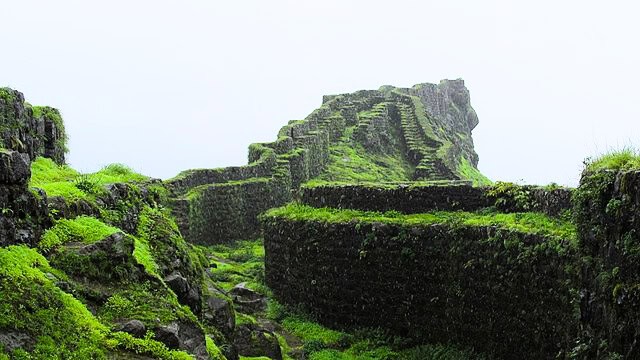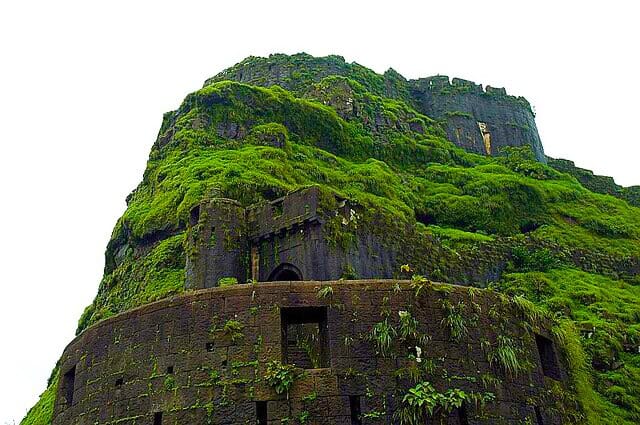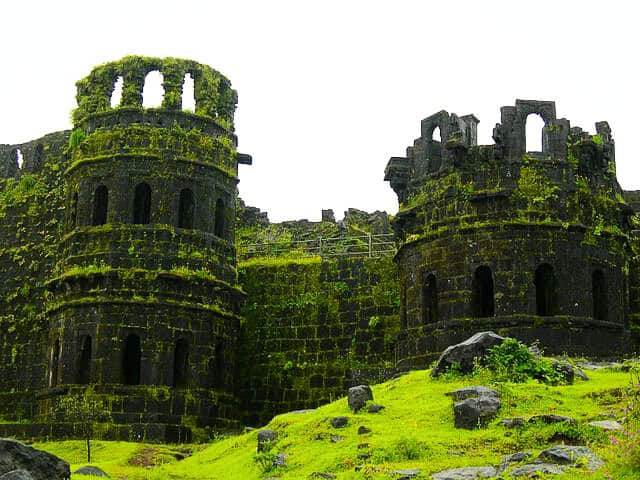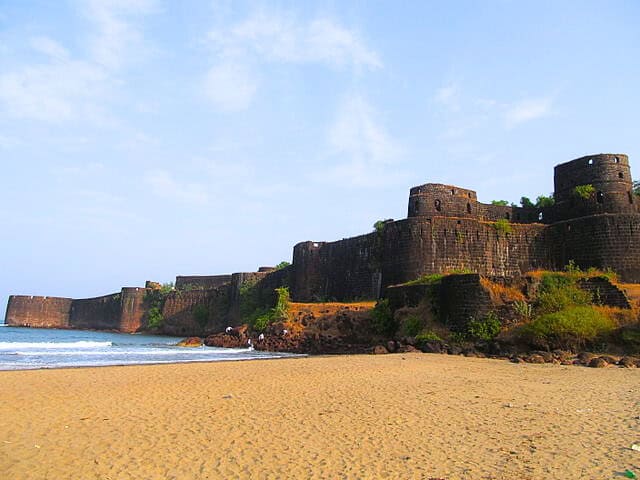Explore 12 mighty Maratha forts that shaped Indian history, now honoured as UNESCO World Heritage Sites.

In 2025, the Maratha Military Landscapes of India were inscribed as a UNESCO World Heritage Site, recognising a unique network of twelve forts that capture the spirit, resilience, and military acumen of the Maratha Empire. There are eleven Maratha Forts in Maharashtra, and one in Tamil Nadu, reflecting both regional strength and national influence. These fortresses are not only architectural marvels but also silent sentinels that have witnessed decisive battles and strategic brilliance.
This guide invites travellers to explore these historic sites, each offering a rich tapestry of culture, landscape, and legacy. Whether perched high in the Sahyadris or nestled by the Arabian Sea, these forts promise an immersive journey into one of India’s most storied eras.
Rajgad Fort, Pune District
Rajgad Fort, located on the Murumbdev hill southwest of Pune, was the capital of the Maratha Empire before Raigad. Built on a massive hill that rises to over 1,300 metres, the fort served as the political centre of the Maratha kingdom for over two decades and witnessed several key moments in Shivaji’s life. It was here that his son, Sambhaji, was born, and his wife, Saibai, passed away.
The fort is divided into several sections, including the Padmavati Machi, Sanjivani Machi, Suvela Machi, and the Balekilla or main citadel. Each section was designed for defence, housing, and strategic operations. The panoramic views offered by the fort made it ideal for monitoring enemy movements. Trekkers are particularly drawn to the climb, which is considered challenging due to steep paths and rugged terrain. The fort’s large area allows for overnight camping, and the Padmavati Temple at the base often serves as a rest point.
Rajgad is best visited between October and February when the climate is cooler and visibility is clearer. While it demands effort to reach the top, the sense of accomplishment, along with the historical richness of the site, makes it a favourite among experienced trekkers and Maratha history enthusiasts. The spirit of Shivaji’s leadership still lingers in its walls and open courtyards.
Salher Fort, Nashik District
Salher Fort sits proudly in the Baglan region of Nashik district and is the highest fort in the Sahyadri range. It stands at 1,567 metres above sea level and commands breathtaking views of the surrounding mountain ranges.
Historically, Salher gained prominence during the Battle of Salher in 1672, a significant conflict in which the Marathas defeated the Mughals under the leadership of Suryajirao Kakade. This victory was crucial for Maratha confidence and expansion. The fort’s strategic location near the Gujarat border allowed it to act as a military outpost and watchpoint for incoming threats.
The summit is home to Gangasagar Lake and a set of ancient temples dedicated to Renuka Mata, Lord Parshuram, and Ganesha. A cluster of around 20 caves and four impressive gates adds to the site’s archaeological interest. Trekkers are drawn to Salher for its moderately challenging trails and the serene plateau that makes it ideal for camping.
Best visited between October and March, the fort becomes a lush green paradise during the monsoon months. With nearby access through the town of Nashik, it offers a mix of heritage and natural beauty that continues to captivate historians and adventurers alike.
Gingee Fort, Villupuram District
Gingee Fort, located in the Villupuram district of Tamil Nadu, is the only Maratha fort outside Maharashtra included in the UNESCO inscription. Sometimes called the “Troy of the East,” Gingee is a vast complex of hilltop citadels spread across three hills: Rajagiri, Krishnagiri, and Chandrayandurg.
Originally built by the Cholas and later expanded by the Vijayanagara Empire, it was briefly held by the Marathas when Shivaji’s son, Rajaram, sought refuge there in the late 17th century. The Maratha fort complex covers a large area and includes granaries, temples, a royal marriage hall known as Kalyana Mahal, and various water tanks.

The steep climbs to each citadel are physically demanding but offer magnificent views of the Tamil countryside. Gingee’s architecture reflects a fusion of South Indian and Deccan military styles, with elements that stand out for their precision and scale. It has witnessed battles involving Marathas, Mughals, the French, and the British, making it a site of multi-layered history. The fort’s current serenity belies its turbulent past. Gingee is an essential stop for those exploring Tamil Nadu’s historical landscape, providing insights into the southern reach of Maratha influence and showcasing a striking architectural blend unique to the region.
Shivneri Fort, Pune District
Located near Junnar in Pune district, Shivneri Fort is one of the most revered sites in Maratha history as the birthplace of Chhatrapati Shivaji Maharaj in 1630. This ancient fort has seen several rulers over time, including the Mauryas, Chalukyas, and Yadavas, before coming under the control of the Mughals and eventually the Marathas. Shivaji’s mother, Jijabai, is believed to have raised him here, and the small structure marking his birth has been preserved with care.
The fort is fortified with seven successive gates that once served as layers of protection against invaders. The central Badami Talav is a water tank that still holds water, while the twin springs named Ganga and Jamuna provided a year-round water supply to the residents. The Shivai Devi Temple, where Shivaji is said to have received his name, continues to draw devotees and visitors.
The fort’s altitude offers splendid views of the Junnar plains, and the trail to the top, although steep, is well-maintained, making it suitable for families and history enthusiasts. Close to attractions like the Lenyadri caves and Junnar Wildlife Sanctuary, Shivneri makes for a culturally enriching day trip that combines heritage with nature.
Lohgad Fort, Pune District
Lohgad Fort is one of the most accessible and popular trekking destinations in Maharashtra. Located near Lonavala and overlooking the picturesque Pawna Lake, Lohgad offers a relatively easy climb that rewards visitors with panoramic views, mist-covered trails, and a deep sense of history.

Originally built during the Satavahana period, the fort changed hands many times before being captured by Shivaji in 1648. It later fell under Mughal control but was reclaimed by the Marathas in 1670. Lohgad was used to store treasures and supplies, given its secure construction and strategic location. The most striking feature is the Vinchukata, or Scorpion’s Tail, a long, narrow spur that resembles a scorpion’s tail curling outward from the main structure. The four large gates, Ganesh Darwaza, Narayan Darwaza, Hanuman Darwaza, and Maha Darwaza, are still intact and evoke the grandeur of their defensive design. During the monsoon, the fort is covered in a lush carpet of green, with small waterfalls and streams appearing along the route.
Its proximity to Bhaja and Karla caves and Visapur Fort makes it an ideal stop on a weekend getaway from Pune or Mumbai. Lohgad is especially loved by beginner trekkers and families looking for a day outdoors, immersed in history.
Khanderi Fort, Raigad District
Khanderi Fort, situated on an island off the coast of Alibag, served as a vital Maratha naval base that safeguarded the Konkan coastline. Constructed in 1679 under the orders of Chhatrapati Shivaji, the fort played a strategic role in controlling sea routes and defending against British and Portuguese forces. It later came under the command of Admiral Kanhoji Angre, the legendary Maratha naval chief, who fortified it further and turned it into a powerful maritime outpost.
The Maratha fort’s location on a rocky islet makes it visually dramatic and historically fascinating. A working lighthouse stands on the island, still guiding vessels through the Arabian Sea, and remnants of Maratha cannons and fort walls provide a glimpse into its defensive capabilities. The Vitthal temple and freshwater cisterns speak of the site’s functionality and enduring importance.
Access to the island is by boat from Thal or Alibag, and trips are subject to tide and weather conditions. While the journey can be short, it offers a refreshing escape and a chance to witness the lesser-known naval chapter of Maratha military history. A visit to Khanderi can easily be paired with beach stops and seafood delights in Alibag for a complete coastal experience.
Raigad Fort, Raigad District
Raigad Fort, often referred to as the “Gibraltar of the East,” was the capital of the Maratha Empire under Chhatrapati Shivaji Maharaj. It is located in the Raigad district and rises dramatically from the surrounding forested hills.
Captured by Shivaji in 1656, Raigad became the site of his coronation as king in 1674, marking the birth of Hindavi Swarajya. The fort was not only a military bastion but also a seat of administration, strategy, and royal life. Visitors today can explore the grand Maha Darwaja, the main entrance flanked by massive bastions, and the remains of palaces, granaries, and royal quarters. Shivaji’s samadhi, or final resting place, is located on the fort grounds along with a statue commemorating his legacy.

The Takmak Tok, a cliff used for punishments, offers breathtaking views of the valleys below. A ropeway now allows quick access to the summit, making the fort more accessible than in the past. The village of Pachad at the base provides lodging options and a starting point for treks. Visiting Raigad is especially moving during Shivaji Jayanti, when ceremonies and reenactments bring the site’s history to life.
Pratapgad Fort, Satara District
Pratapgad Fort, located in the Satara district near Mahabaleshwar, was built by Shivaji in 1656 to defend the Par Pass and the trade routes of the Western Ghats. It is best known as the site of the legendary battle between Shivaji and Afzal Khan in 1659. This event, marked by strategy and surprise, is celebrated in Maratha lore and continues to be recounted in folk tales and historical narratives.
The fort is perched on a spur of the Sahyadri range and consists of two main sections—the upper fort and the lower fort. The Bhavani Temple, constructed by Shivaji, is still active and a significant spiritual site for devotees. Close to the temple lies the spot where Shivaji is said to have encountered Afzal Khan, now marked by a small memorial and Afzal Khan’s tomb nearby. The fort’s watchtowers and bastions are remarkably well-preserved and offer dramatic views of the lush valleys and mountains surrounding Mahabaleshwar.
The approach road makes the site accessible by car, and day-trippers often combine it with a visit to the nearby hill station. Pratapgad is both a symbol of strategic brilliance and a deeply emotional site for followers of Shivaji’s legacy. It provides visitors with a vivid experience of Maratha valour and determination.
Suvarnadurg Fort, Ratnagiri District
Suvarnadurg Fort is an island fort located off the coast of Harnai in Ratnagiri district, and it holds a prominent place in Maratha naval history. Constructed during Shivaji’s reign in the 1660s, the fort was a part of his coastal defence strategy. Later, it came under the control of Kanhoji Angre, the admiral of the Maratha navy, who used it as a key naval base to protect the Konkan coastline.
Built with sturdy stone walls and well-planned bastions, this Maratha fort served as a stronghold against foreign invasions and pirate activities. The fort is accessible only by boat, and reaching it depends on tide conditions, adding a sense of adventure to the journey. Once on the island, visitors can explore the fort’s defensive structures, hidden water tanks, and scenic viewpoints. Though the interior is partially in ruins, the atmosphere remains powerful and evocative. The surrounding sea, especially during sunrise or sunset, offers a magnificent backdrop.
Many tourists pair a visit to Suvarnadurg with stops at nearby fishing villages and beaches, making it a peaceful yet historically rich destination. It is a rare example of Maratha naval architecture, offering a glimpse into a maritime past that is often overshadowed by the empire’s land-based conquests.
Vijaydurg Fort, Sindhudurg District
Vijaydurg Fort, located along the Konkan coast in Sindhudurg district, is one of the most formidable sea forts built by the Marathas. Originally constructed in the 13th century by the rulers of the Shilahar dynasty, it was later strengthened by Shivaji in the 17th century.

The fort features thick laterite stone walls, robust bastions, and a remarkable underwater wall, which is believed to have served as a naval defence barrier. This submerged wall is considered a marvel of ancient marine engineering. Vijaydurg represents the peak of Maratha maritime architecture and their emphasis on naval dominance.
The approach to the fort, once only by boat, is now possible via a narrow land connection. Inside, visitors can explore courtyards, ancient gates, and hidden passageways. The sea views are particularly stunning and attract photographers and history lovers alike. It remains less crowded than some other coastal forts, giving travellers a more peaceful and immersive experience. Nearby beaches and the quiet village of Devgad add to its charm.
Panhala Fort, Kolhapur District
Located near Kolhapur, Panhala Fort is one of the largest and most historically significant hill forts in Maharashtra. It played a crucial role during Shivaji’s military campaigns, particularly during his daring escape from Siddi Johar’s siege in 1660.
The fort’s origins trace back to the Shilahara dynasty, with later additions by the Bahamanis and Adil Shahi rulers before it came under Maratha control. Panhala’s vast complex includes the Teen Darwaza (a grand gateway), the hidden well known as Andhar Bavadi, and the Sajja Kothi, which was used as a watchtower. The granaries or Ambarkhana are a unique feature, highlighting the Maratha emphasis on logistical preparedness. Set on a high plateau, the fort provides excellent views of the surrounding plains and is especially beautiful during the monsoon season when it is blanketed in green.
The fort is accessible by road and has accommodation options in the nearby town, including heritage hotels. Panhala is not only a site for military history but also a place of cultural events, such as the Sajja Kothi festival. For visitors who enjoy walking through history with a touch of comfort, Panhala offers an ideal mix of accessibility, scenic beauty, and legacy.
Sindhudurg Fort, Sindhudurg District
Built between 1664 and 1667, Sindhudurg Fort stands on a rocky island just off the coast of Malvan in Sindhudurg district. It was constructed by Shivaji to counter foreign naval threats and assert Maratha presence on the Konkan coast. Surrounded by the Arabian Sea on all sides, the fort is accessible by boat and remains one of the most remarkable examples of coastal fortifications in India.
Its walls stretch for over three kilometres, and the entrance is cleverly hidden, designed to confuse potential invaders. Inside, visitors will find several temples, including one dedicated to Shivaji himself, which is believed to have his footprints cast in stone. There are also freshwater wells and watchtowers that offer panoramic views of the sea.
Sindhudurg is popular among tourists not only for its history but also for water-based activities such as scuba diving and snorkelling, which are offered around the fort’s clear waters. The nearby town of Malvan is known for its spicy seafood and relaxed coastal vibe, making this fort a great addition to both cultural and leisure itineraries. A visit to Sindhudurg provides a deep dive into the Maratha naval past, complemented by nature and local hospitality.
Travel Essentials and Insider Tips
Exploring the Maratha Military Landscapes is a journey through history, terrain, and regional culture. While many forts are accessible by road, some island forts require boat rides, and hill forts may demand a bit of trekking stamina. It is important to plan your trip, keeping in mind seasonal weather, local transport availability, and accommodation.
The best time to explore these Maratha forts is between October and March. During this period, the skies are clear, temperatures are mild, and trekking conditions are ideal. The monsoon season from June to September transforms the Sahyadris into lush green carpets, with waterfalls and misty surroundings enhancing the atmosphere, but it can make trails slippery and some boat services unreliable.
For transportation, most of the mainland Maratha forts can be accessed by road from major cities such as Pune, Mumbai, Kolhapur, and Nashik. The island forts, like Sindhudurg, Suvarnadurg, and Khanderi, require boat rides, usually available from coastal towns such as Malvan, Alibag, and Harnai. Local transport, like jeeps or private taxis, is helpful for reaching remote base villages. Some places, like Raigad, now have ropeway facilities, while others may require a full-day trek.
Accommodation varies from heritage homestays and basic guesthouses to luxury resorts near major towns. Many forts, such as Panhala and Rajgad, are popular with trekkers who prefer to camp overnight in designated zones. Carry essentials such as sturdy footwear, sunscreen, insect repellent, a flashlight, water bottles, and basic first aid. Mobile coverage may be weak in remote areas, and it is wise to carry some cash, as ATMs are not always nearby.
When visiting these sites, respect local customs and religious practices, especially at temples within fort complexes. Avoid littering or defacing heritage structures. Supporting local guides, artisans, and homestays ensures that tourism continues to benefit the communities who have preserved these stories for generations.
Read More: Latest



